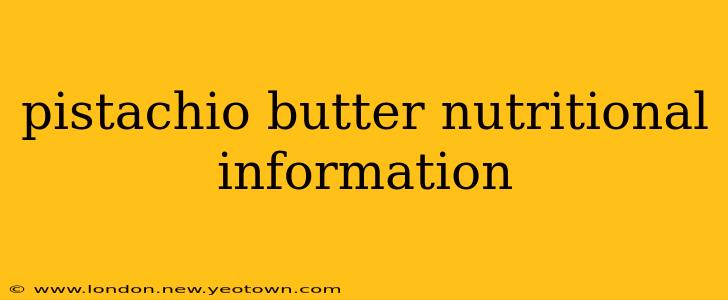Pistachio butter. Just the name conjures images of creamy green goodness spread on toast, swirled into smoothies, or enjoyed straight from the jar. But beyond its delicious taste, pistachio butter packs a serious nutritional punch. Let's delve into the world of this delightful and healthy spread, exploring its nutritional profile and answering some common questions.
What are the nutritional benefits of pistachio butter?
The journey to understanding pistachio butter's nutritional benefits begins with recognizing its primary ingredient: pistachios. These little green gems are powerhouses of nutrients. Pistachio butter, therefore, inherits many of these benefits, concentrating them into a convenient and tasty package. We're talking about healthy fats, protein, fiber, and a good dose of vitamins and minerals. It's a far cry from many other nut butters that are heavily processed and laden with added sugars.
How many calories are in a serving of pistachio butter?
A typical serving size (about two tablespoons) of pistachio butter contains roughly 190-200 calories. However, this can vary slightly depending on the brand and any added ingredients (like salt or sugar). It’s always best to check the nutrition label on the specific jar you're using. Remember, while calories matter, the nutritional density of pistachio butter makes those calories work for you, providing sustained energy and essential nutrients.
Is pistachio butter good for weight loss?
This is a question many are curious about. While pistachio butter is calorie-dense, its healthy fats, fiber, and protein contribute to satiety. This means you feel fuller for longer, potentially reducing overall calorie intake and aiding in weight management. However, moderation is key. Like any high-calorie food, consuming excessive amounts of pistachio butter can hinder weight loss efforts. Incorporating it mindfully as part of a balanced diet is the best approach.
How does pistachio butter compare to other nut butters?
Compared to other nut butters like peanut butter or almond butter, pistachio butter often boasts a higher concentration of certain nutrients. For example, it tends to be richer in antioxidants and vitamin E. It also generally has a slightly lower saturated fat content than some other nut butters. However, all nut butters offer unique nutritional profiles, and the "best" choice depends on individual dietary needs and preferences.
What are the potential downsides of eating pistachio butter?
While generally healthy, pistachio butter does have some potential drawbacks to consider. Individuals with nut allergies should obviously avoid it. Additionally, some people might find it difficult to digest large quantities due to its high fat content. And, as with any food, moderation is key to reaping its health benefits without any negative consequences.
Can I make my own pistachio butter at home?
Absolutely! Making your own pistachio butter is a surprisingly simple process. All you need are roasted, unsalted pistachios and a food processor. Simply blend until smooth, adding a touch of oil (like olive oil) if needed to achieve the desired consistency. This gives you complete control over the ingredients, ensuring no added sugars or unhealthy fats.
Is pistachio butter good for diabetics?
Pistachio butter contains healthy fats and fiber that can help regulate blood sugar levels. However, due to its calorie and carbohydrate content, it’s important for diabetics to consume it in moderation and monitor their blood sugar levels after consumption. Always consult with your doctor or a registered dietitian for personalized dietary advice.
The rich, creamy texture and incredible flavor of pistachio butter make it a delicious and nutritious addition to a balanced diet. From boosting your energy levels to contributing to satiety, this versatile spread offers a host of health benefits. Remember, moderation and mindful consumption are key to maximizing its nutritional value.

